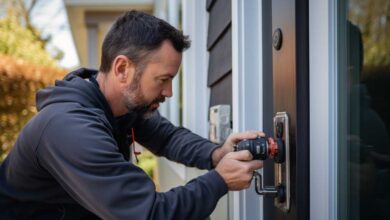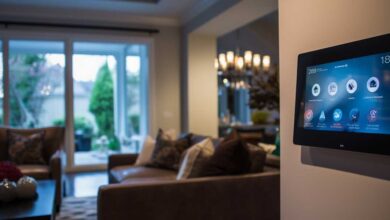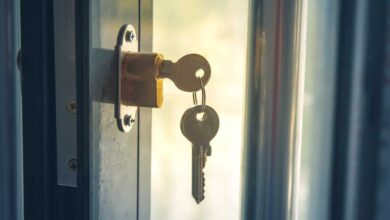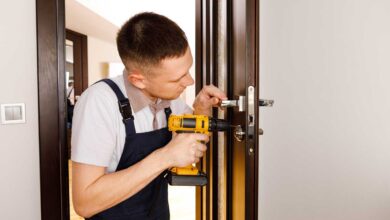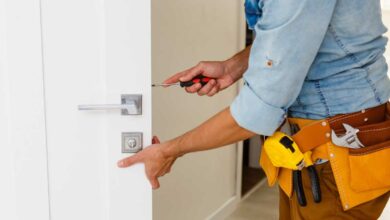Troubleshooting Common Smart Lock Problems
KEY TAKEAWAYS
In today’s digitally powered world, smart locks have become a popular choice for many homeowners due to their enhanced security features and convenience. However, just like any other digital device, smart locks are not immune to malfunctions and technical glitches.
The blog will guide you through some of the most common issues you might encounter with your smart lock, providing step-by-step solutions to help you troubleshoot these problems efficiently and effectively.
What Is A Smart Lock?
A Smart Lock is an advanced locking system that offers enhanced security and convenience for homeowners and businesses. Unlike traditional locks, smart locks use digital mechanisms and often integrate with smart home systems, allowing users to lock or unlock doors remotely through a smartphone app or voice commands. They can also provide real-time alerts, track access history, and even integrate with other smart devices for a seamless home automation experience.
Common Problems With Smart Locks
While smart locks offer a plethora of benefits, they are not immune to issues. Some of the most common problems users face include connectivity issues, unresponsive touchpads, and, most notably, battery life concerns.
Battery Life Issues
One of the primary concerns with smart locks is their dependency on batteries. If the battery dies, the smart lock may become unresponsive, leaving users locked out of their homes or offices.
Types Of Batteries Used In Smart Locks
Smart locks typically use one of the following types of batteries:
-
Alkaline Batteries: These are the most common type of batteries used in smart locks. They are readily available and relatively inexpensive.
-
Lithium Batteries: These batteries offer a longer lifespan than alkaline batteries and perform better in extreme temperatures.
-
Rechargeable Batteries: Some smart locks come with built-in rechargeable batteries. They can be charged using a USB cable or a dedicated charging dock.
Checking The Battery Level
It’s essential to regularly check the battery level of your smart lock to prevent unexpected lockouts. Most smart lock apps provide a battery level indicator, alerting users when the battery is low. Some locks also have LED indicators on the lock itself, which change color or flash to indicate a low battery.
Replacing Dead Batteries
When the battery level is critically low:
-
Open the smart lock app on your smartphone to check for specific battery replacement instructions for your lock model.
-
Turn off the lock (if applicable) before replacing the batteries.
-
Remove the old batteries and ensure you dispose of them properly.
-
Insert the new batteries, ensuring the polarity is correct.
-
Turn the lock back on and test it to ensure it’s functioning correctly.
Keeping The Battery Compartment Clean And Dry
To ensure the longevity of your smart lock and its battery:
-
Avoid exposing the lock to extreme weather conditions.
-
Regularly clean the battery compartment to remove any dust or debris.
-
Ensure the battery compartment is dry. If you notice any moisture, dry it immediately to prevent corrosion.
Software Issues
As with many digital devices, smart locks can sometimes experience software-related problems. These can range from minor glitches to more significant issues that prevent the lock from functioning correctly. According to a survey conducted by AV-TEST in 2020, 13 out of 16 smart locks tested were found to have serious security vulnerabilities. This underlines the importance of addressing software-related problems promptly to ensure the security of one’s property. Addressing these issues promptly can ensure the security of your property and the smooth operation of your smart lock.
Updating The Firmware/Software Of A Smart Lock
Regularly updating the firmware or software of your smart lock is crucial for its optimal performance. Manufacturers often release updates to fix bugs, enhance security features, or add new functionalities.
-
Check For Updates: Most smart lock apps have a section where you can check for available updates. Ensure your smartphone is connected to the internet and open the smart lock app.
-
Backup Settings: Before updating, it’s wise to backup any configurations or settings. This ensures that you can restore your preferences if something goes awry during the update.
-
Follow On-Screen Instructions: Once you initiate the update, the app will typically guide you through the process. Ensure your smartphone remains close to the lock and maintains a stable internet connection throughout the update.
-
Test The Lock: After the update is complete, test the lock to ensure it’s functioning correctly. If you encounter any issues, consult the manufacturer’s support resources.
Connectivity Issues
Connectivity issues can prevent your smart lock from communicating with your smartphone or other smart devices. Here are some steps to troubleshoot:
-
Check The Internet Connection: Ensure that your home’s Wi-Fi network is active and stable. You can do this by checking other devices connected to the same network.
-
Restart The Smart Lock: Sometimes, simply restarting the smart lock can resolve connectivity issues. Refer to the user manual for instructions on how to safely restart your specific model.
-
Reconnect To The Network: If the lock is still not connecting, try removing it from your network and then reconnecting it. This process can refresh the connection and resolve minor glitches.
-
Check For Interferences: Other electronic devices or thick walls can sometimes interfere with the smart lock’s connectivity. Ensure the lock is within the recommended range of your Wi-Fi router, and consider relocating any potential sources of interference.
Factory Resetting The Device
If all else fails, a factory reset might be necessary. This action will erase all configurations and return the lock to its original settings. Here’s how to do it:
-
Backup Important Data: Before performing a factory reset, backup any essential configurations or user access data.
-
Initiate The Reset: The process for initiating a factory reset varies between models. Consult the user manual or the smart lock app for specific instructions.
-
Reconfigure The Lock: After the reset, you’ll need to set up the lock from scratch. This includes reconnecting it to your network, reconfiguring settings, and granting access to users.
-
Update The Software: It’s a good practice to check for software updates after a factory reset to ensure your lock has the latest security patches and features.
Physical Lock Issues
While smart locks are primarily digital, they still have physical components that can experience wear and tear over time. Addressing these physical issues is crucial to ensure the security of your property and the longevity of your smart lock.
Jammed Or Stuck Door Locks
A jammed or stuck door lock can be a significant inconvenience, preventing you from accessing your property. Here’s how to address this issue:
-
Lubricate The Lock: Over time, dirt and debris can accumulate inside the lock, causing it to jam. Use a graphite-based lubricant to clean and lubricate the lock. Avoid using oil-based lubricants as they can attract more dirt.
-
Check For Misalignment: Doors can shift due to changes in temperature and humidity, causing misalignment with the frame. Ensure the door is properly aligned with the frame and make any necessary adjustments.
-
Inspect For Damaged Parts: If the lock remains jammed, there might be broken or damaged components inside. In such cases, it’s best to consult a professional locksmith or consider replacing the lock.
Worn Out Keypads
Keypads are often the first component to show signs of wear, especially if used frequently. Here’s how to address worn-out keypads:
-
Clean The Keypad: Dirt, oil, and other residues can accumulate on the keypad, affecting its responsiveness. Use a soft cloth and a mild cleaning solution to gently clean the keypad.
-
Check For Physical Damage: Inspect the keypad for any visible signs of damage, such as cracks or broken buttons. If damaged, the keypad might need replacement.
-
Calibrate The Keypad: Some smart locks allow users to recalibrate the keypad through the app. This can improve responsiveness and accuracy.
Troubleshooting Tips For Common Smart Lock Problems
-
Stay Updated: Regularly update the software or firmware of your smart lock to ensure optimal performance and security.
-
Regular Maintenance: Periodically inspect and clean your smart lock, both its digital and physical components, to prevent issues.
-
Consult The User Manual: The user manual often contains valuable troubleshooting tips and solutions for common problems. Keep it handy for reference.
-
Seek Professional Help: If you’re unable to resolve an issue, consult a professional locksmith or the lock’s manufacturer. They can provide expert guidance and solutions.
-
Backup Access: Always have a backup method of accessing your property, such as a traditional key or a secondary smart lock. This ensures you’re never locked out due to a malfunctioning lock.
Frequently Asked Questions
We have addressed some of the most commonly asked queries to help you in troubleshooting common smart lock problems.
What should I do if I forget my smart lock passcode?
If you’ve forgotten your smart lock passcode, don’t panic. Most smart locks come with a recovery process or secondary authentication method. Check the user manual for specific recovery steps tailored to your lock model. Additionally, some smart locks allow users to reset or retrieve their passcode through associated apps or email verification. Always ensure you have a backup access method, such as a physical key.
How often should I update my smart lock’s software?
Regular software updates are crucial for the optimal functioning of your smart lock. It’s recommended to check for updates at least once a month. These updates often contain security patches, bug fixes, and new features that enhance the lock’s performance and security. Enable automatic updates if your lock supports it, ensuring you always have the latest version.
Can extreme weather conditions affect my smart lock’s performance?
Yes, extreme weather conditions, be it scorching heat or freezing cold, can impact the efficiency and lifespan of your smart lock, especially its battery. Some locks are designed to withstand such conditions better than others. If your lock is exposed to the elements, consider investing in protective measures like weather shields or covers. Regular maintenance can also mitigate weather-related issues.
Is it safe to use smart locks for main entrances?
Smart locks, especially those from reputable brands, are designed with robust security features, making them suitable for main entrances. They often employ advanced encryption methods, making them as secure, if not more so, than traditional locks. However, always do thorough research, read reviews, and ensure the model you choose meets industry security standards.
How long do the batteries in a smart lock typically last?
The longevity of smart lock batteries largely depends on usage frequency and the type of battery. On average, smart lock batteries can last between 6 months to a year. Some high-end models with energy-efficient features might last even longer. It’s essential to regularly check the battery status, either through the lock’s LED indicators or its associated app, and replace them when needed.
Can smart locks be hacked?
While no electronic device is entirely hack-proof, leading smart lock manufacturers prioritize security. They employ advanced encryption techniques and continuously update their software to counter potential threats. Users can further enhance security by setting strong, unique passcodes and enabling two-factor authentication if the lock supports it.
Troubleshooting Common Smart Lock Problems
Smart locks represent a fusion of traditional security with modern technology. While they offer unparalleled convenience and enhanced security features, like all devices, they can encounter challenges. By staying informed, conducting regular maintenance, and seeking expert advice when needed, you can maximize the benefits of your smart lock and ensure the safety of your property. Remember, as technology evolves, so do the solutions to potential problems. Stay updated, stay secure.
Discover more about how to keep your house and family safe by reading our in-depth guide on the security advantages of smart home automation. For additional information, visit Security Forward and explore our resources and guides.
